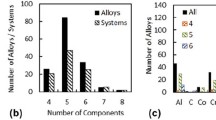Abstract
Ir doping is an effective method used to strengthen and toughen Pt–Rh alloy and improve its high-temperature properties. However, Ir and Pt–Rh alloys are infinite solid solution alloys, and their microstructures are difficult to observe to understand their mechanism of action. Therefore, the stability and mechanical and thermal properties of a series of Pt–20Rh–xIr (x = 0, 5, 10 and 20) alloys were calculated using first-principle studies based on density functional theory. The results show that with an increase in the Ir content, the Young’s modulus and hardness of Pt–20Rh–xIr initially decrease and then increase. The largest Young’s modulus (436.243 GPa) and hardness (18.453 GPa) were achieved when the Ir content was 20 wt%. Meanwhile, the thermodynamic calculation results show that with an increase in the Ir content, the thermal stability of Pt–20Rh–xIr was significantly improved, and the thermal expansion coefficient of Pt–20Rh–xIr was only 63% of that observed for Pt–20Rh. The above results imply that the addition of 20 wt% Ir gave the best effect on improving the strength, toughness and high temperature properties of Pt–20Rh alloy. This study provides theoretical guidance for further application of Pt–Rh alloy in the aviation field.








Similar content being viewed by others
References
Jiang K, Zhao D, Guo S, Zhang X, Zhu X, Guo J, Lu G, and Huang X, Sci Adv 3 (2017) e1601705.
Rao C R M, and Reddi G S, TrAC Trends Anal Chem 19 (2000) 565.
Seymour RJ, O’Farrelly JI, Potter LC (2000) Kirk-Othmer Encycl Chem Technol
Dereli G, Cagin T, Uludogan M, and Tomak M, Philos Mag Lett 75 (1997) 209.
Kalinin I A, Roslyakov I V, Tsymbarenko D M, Bograchev D A, Krivetskiy V V, and Napolskii K S, Sens Actuator A Phys 317 (2021) 112457.
Rdzawski Z M, and Stobrawa J P, J Mater Process Technol 153 (2004) 681.
Dai Y, Ma Q Y, Liu W T, Hu F P, Zhang Y, Yang Z L, Tang H Y, Wei G B, and Xie W D, Mater Sci Technol 34 (2018) 654.
Zhonghua S, Xiaodong P, Weidong X, Weiting L, and Zonglun Y, Rare Metal Mater Eng 41 (2012) 402.
Hu F, Yu T, Liu W, Yang Y, Wei G, Luo X, Tang H, Hansen N, Huang X, and Xie W, Mater Sci Eng A 765 (2019) 138305.
Wilson F G, and Stanley R G, High Temp Technol 2 (1984) 129.
Okamoto H, J Ph Equilib Diffus 34 (2013) 176.
Yao X, Mao Y, and Guo Y F, Philos Mag 101 (2021) 1033.
Lanzillo N A, J Appl Phys 121 (2017) 175104.
Hamann D R, Schlüter M, and Chiang C, Phys Rev Lett 43 (1979) 1494.
Wang S, Xiong J, Li D, Zeng Q, Xiong M, and Chai X, Mater Lett 282 (2021) 128754.
Lee S J, Kwon T S, Nahm K, and Kim C K, J Phys Condens Matter 2 (1990) 3253.
Blanco M A, Francisco E, and Luana V, Comput Phys Commun 158 (2004) 57.
Hammer B, Hansen L B, and Nørskov J K, Phys Rev B 59 (1999) 7413.
Perdew J P, and Wang Y, Phys Rev B 45 (23), (1992) 13244.
Karki B B, Ackland G J, and Crain J, J Phys Condens Matter 9 (1997) 8579.
Zuo L, Humbert M, and Esling C, J Appl Crystallogr 25 (1992) 751.
Bellaiche L, and Vanderbilt D, Phys Rev B 61 (2000) 7877.
Birch F, Phys Rev 71 (1947) 809.
Sin’Ko G V, and Smirnov N A, J Phys Condens Matter 14 (2002) 6989.
Pugh S F, Lond Edinb Dublin Philos Mag J Sci 45 (1954) 823.
Chen X Q, Niu H, Li D, and Li Y, Intermetallics 19 (2011) 1275.
Otero-de-la-Roza A, Abbasi-Pérez D, and Luaña V, Comput Phys Commun 182 (2011) 2232.
Andritsos E I, Zarkadoula E, Phillips A E, Dove M T, Walker C J, Brazhkin V V, and Trachenko K, J Phys Condens Matter 25 (2013) 235401.
Acknowledgements
This research was sponsored by the National Natural Science Foundation of China (No. 52161005), The Major Science and Technology Program of Yunnan, China (2019ZE001 and 202002AB080001-1) and Natural Science Foundation of Yunnan, China (2019FA048 and 2019FI020), The Basic Research Plan of Yunnan Science and Technology Department (grant Nos. 202101AU070098 and 202203ZA080001); Kunming University of Science and Technology University-level talent training program (grant Nos. KKZ3202056044).
Author information
Authors and Affiliations
Corresponding author
Additional information
Publisher's Note
Springer Nature remains neutral with regard to jurisdictional claims in published maps and institutional affiliations.
Rights and permissions
Springer Nature or its licensor (e.g. a society or other partner) holds exclusive rights to this article under a publishing agreement with the author(s) or other rightsholder(s); author self-archiving of the accepted manuscript version of this article is solely governed by the terms of such publishing agreement and applicable law.
About this article
Cite this article
Chengling, W., Wanbing, Y., Hua, D. et al. First-Principles Study on the Effect of Ir Doping on the Mechanical and Thermodynamic Properties of Pt–20Rh Alloy. Trans Indian Inst Met 76, 3393–3401 (2023). https://doi.org/10.1007/s12666-023-02974-6
Received:
Accepted:
Published:
Issue Date:
DOI: https://doi.org/10.1007/s12666-023-02974-6




